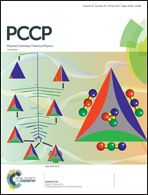Dynamics of carbon monoxide dissociation on Co(11![[2 with combining macron]](https://www.rsc.org/images/entities/char_0032_0304.gif) 0)
0)
Abstract
The dissociative chemisorption dynamics of CO on rigid Co(11![[2 with combining macron]](https://www.rsc.org/images/entities/char_0032_0304.gif) 0) is investigated using a quasi-classical trajectory method on a new global six-dimensional potential energy surface (PES). The PES is fit using a neural network method to represent 24 630 density functional energies in various configurations. The reaction path features deep chemisorption wells and a late barrier for dissociation, agreeing well with previous calculations. The activation energy for dissociation ranges from 0.1 eV at the hollow site to 2.46 eV on the top site, indicating a highly corrugated PES. Effects of the incidence energy of the impinging molecule, its initial orientation, vibrational and rotational excitations, and site specificity are examined. Despite the presence of a low barrier, the initial dissociation probability is very small, even at high incident energies, as a large percentage of trajectories is either trapped or desorbed back to the gas phase. The low reactivity is attributed to inefficient energy transfer into the dissociation reaction coordinate in the chemisorption well where thermal equilibrium is not reached. This system underscores the importance of dynamics in understanding reactions at gas–surface interfaces and in kinetic modeling of catalytic processes.
0) is investigated using a quasi-classical trajectory method on a new global six-dimensional potential energy surface (PES). The PES is fit using a neural network method to represent 24 630 density functional energies in various configurations. The reaction path features deep chemisorption wells and a late barrier for dissociation, agreeing well with previous calculations. The activation energy for dissociation ranges from 0.1 eV at the hollow site to 2.46 eV on the top site, indicating a highly corrugated PES. Effects of the incidence energy of the impinging molecule, its initial orientation, vibrational and rotational excitations, and site specificity are examined. Despite the presence of a low barrier, the initial dissociation probability is very small, even at high incident energies, as a large percentage of trajectories is either trapped or desorbed back to the gas phase. The low reactivity is attributed to inefficient energy transfer into the dissociation reaction coordinate in the chemisorption well where thermal equilibrium is not reached. This system underscores the importance of dynamics in understanding reactions at gas–surface interfaces and in kinetic modeling of catalytic processes.
![Graphical abstract: Dynamics of carbon monoxide dissociation on Co(11 [[2 with combining macron]] 0)](/en/Image/Get?imageInfo.ImageType=GA&imageInfo.ImageIdentifier.ManuscriptID=C7CP01697B&imageInfo.ImageIdentifier.Year=2017)


 Please wait while we load your content...
Please wait while we load your content...
![[2 with combining macron]](https://www.rsc.org/images/entities/h2_char_0032_0304.gif) 0)
0)